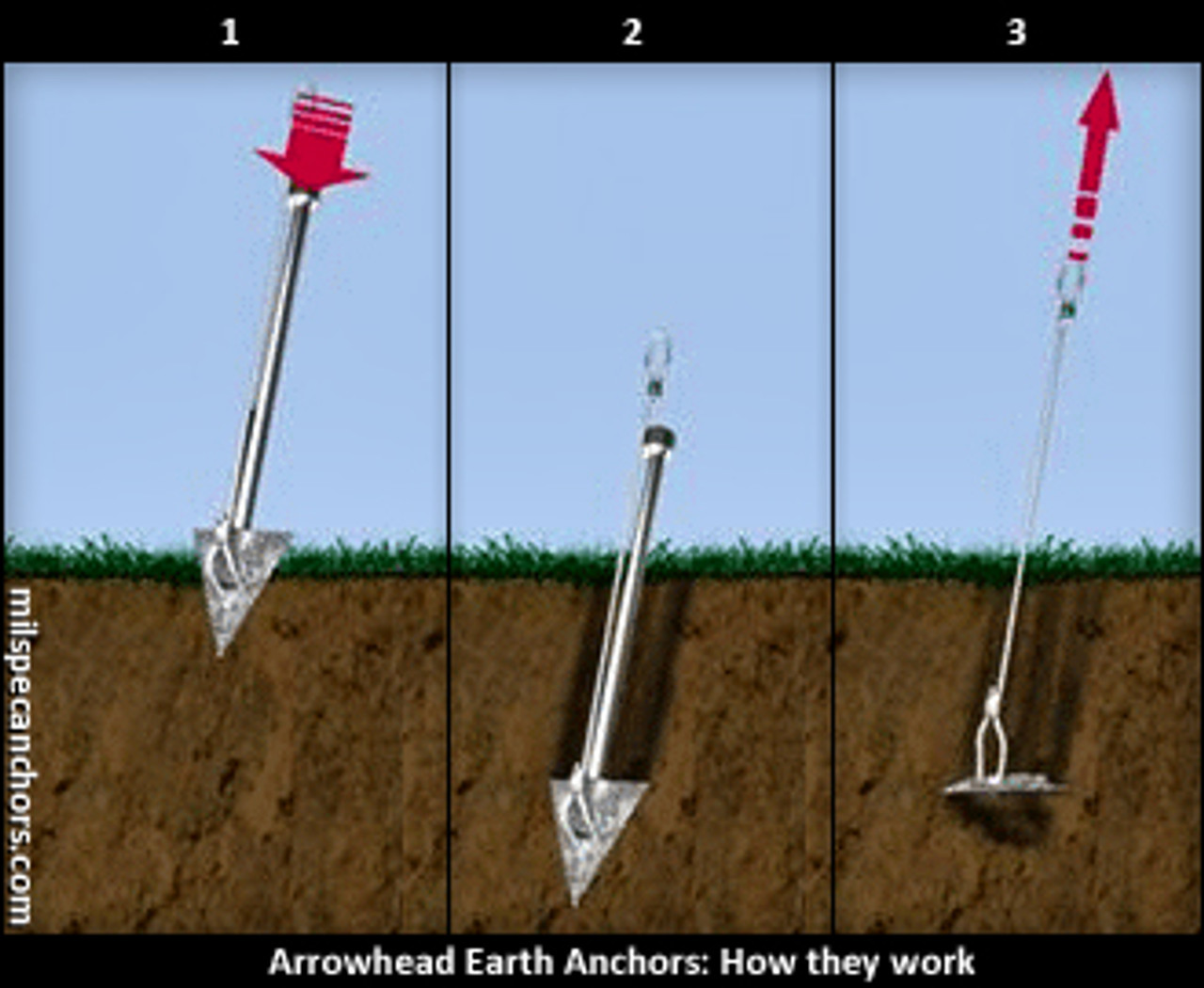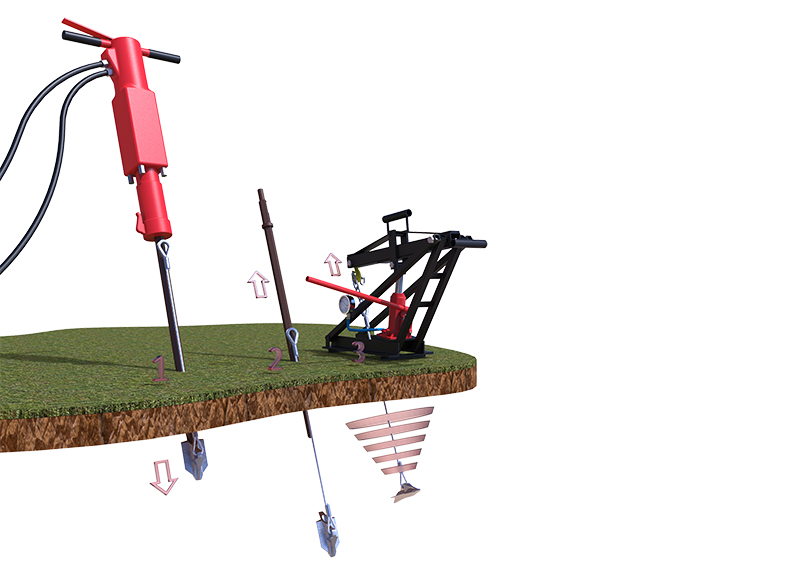How Durable Earth Anchors Work: A Comprehensive Overview to Soil Anchoring Solutions
Sturdy Earth anchors play an essential duty in supplying security and assistance in numerous construction applications. By installing deeply right into the ground, they resist upright and lateral forces efficiently. Different types of anchors deal with various soil problems, making them versatile. Recognizing their auto mechanics and installment methods is essential for making the most of efficiency. What aspects influence their effectiveness, and how do they contrast to standard approaches? The solutions may surprise you.
Recognizing Heavy-Duty Earth Anchors
Sturdy Earth anchors work as necessary elements in different building and construction and landscaping tasks, supplying stability and support in tough soil problems. These supports work by being installed into the ground, where they stand up to lateral and upright pressures. Their design enables for safe and secure accessory to frameworks, ensuring they stay anchored versus dirt activity or outside loads.The effectiveness of heavy-duty Earth supports greatly depends on the kind of dirt and the anchor's installment depth. Correct installment techniques are essential, as they figure out the support's holding capacity. Environmental elements, such as dampness and freeze-thaw cycles, can additionally affect performance.These supports are regularly made use of in applications ranging from safeguarding fencings and retaining wall surfaces to maintaining momentary structures during unfavorable weather problems. Comprehending the concepts behind heavy-duty Earth anchors is important for specialists looking for to improve the longevity and security of their tasks.
Types of Heavy-Duty Earth Anchors
Various types of durable Earth supports are developed to meet details needs based upon dirt problems and project needs. Helical supports, including screw-like blades, work in softer soils, using high lots capabilities and easy setup. Driven supports, which are hammered right into the ground, appropriate for rough surfaces and offer immediate load assistance. Tie-back anchors are generally made use of in preserving wall surface applications, enabling for lateral support by anchoring right into the ground at an angle. Another kind is the cast-in-place support, suitable for concrete applications, as they are integrated right into structures for enhanced stability. Ultimately, soil screw supports are functional choices that can be made use of in different dirt types, giving trusted stress and compression capacities. Each type offers distinctive applications, guaranteeing stability and safety in building and landscape design jobs. Comprehending these options permits notified decisions in selecting the appropriate Earth anchoring option.
The Mechanics of Dirt Anchoring

Understanding the auto mechanics of dirt anchoring needs an examination of different kinds of Earth supports and their installment techniques. Each anchor type presents distinct characteristics that affect its performance in different soil conditions. Proper setup approaches are crucial for maximizing the securing system's security and performance.
Kinds Of Earth Anchors
Earth supports, necessary elements in dirt anchoring systems, been available in a number of kinds, each created for certain applications and dirt conditions. The most usual types consist of screw anchors, which are turned into the ground, providing solid side resistance. Helical supports include blades that enable for reliable setup in numerous dirt types, making them ideal for both long-term and temporary applications. Driven supports, generally made from steel, are inculcated the soil and are effective in rocky or dense environments. Auger supports utilize a helical style to promote setup in softer dirts. Finally, plate anchors consist of a flat plate hidden flat, distributing load over a bigger location, perfect for applications calling for high lots capacities in cohesive soils.
Installment Techniques Clarified
Appropriate installation methods are essential for the efficiency of soil anchoring systems. The procedure usually begins with website assessment, validating the picked area can sustain the support's load. After identifying the right anchor kind, appropriate hole deepness and angle should be established. The installment involves driving the support right into the ground making use of specialized tools, such as hand-operated or hydraulic motorists, to accomplish best embedment. Post-installation, tensioning the support is vital to assure security; this is frequently verified with tons screening. In addition, bordering dirt conditions ought to be checked to stop displacement. Adhering to these methods not just improves the support's performance however also prolongs its life expectancy, giving reputable support for numerous applications.
Applications of Heavy-Duty Earth Anchors
While durable Earth supports are often linked with building and landscaping, their adaptability prolongs to a variety of applications throughout various sectors. In civil design, they supply necessary support for preserving walls, making sure security in locations prone to dirt erosion. The aquatic field utilizes these supports for protecting anchors and marinas, stopping motion triggered by currents and trends. Furthermore, in the telecom market, sturdy Earth supports are significant for maintaining cell towers and other high structures against wind forces. Agricultural applications likewise profit, as these supports can secure frameworks like greenhouses and livestock fencing, guaranteeing they endure severe climate condition. In eco-friendly power jobs, such as wind ranches, Earth anchors play an important function in protecting wind turbine foundations, boosting general security and performance. This broad variety of applications highlights the flexibility and dependability of sturdy Earth anchors across various areas.
Benefits Over Typical Anchoring Approaches
Traditional anchoring techniques have long been counted upon for stability, sturdy Earth anchors offer significant benefits that boost efficiency and effectiveness. One significant benefit is their premium load-bearing capacity, which permits them to withstand better pressures without check out here failure. This toughness makes them ideal for demanding applications, such as in building and construction and utility installations.Additionally, durable Earth anchors are designed for much deeper installation, giving better security in numerous soil conditions, including loose or sandy soils. Their resistance to deterioration and ecological elements guarantees a much longer life-span and reduced maintenance prices contrasted to standard methods.Moreover, these supports can be mounted with marginal disturbance to the surrounding area, preserving the integrity of the landscape. On the whole, heavy-duty Earth supports present a reliable and trusted option for anchoring demands, exceeding the restrictions commonly associated with standard anchoring techniques.
Installment Process and Finest Practices
The installation process for dirt securing remedies begins with thorough prep work and website evaluation to guarantee peak performance. Following this, a step-by-step setup guide offers clear guidelines for effective execution (construction site anchors). Sticking to these finest methods is essential for accomplishing resilient and trusted anchoring results
Prep Work and Website Evaluation
Reliable preparation and complete site evaluation are crucial action in the setup of dirt securing services. Prior to setup, the soil type have to be evaluated to identify its bearing capability and suitability for securing. Conducting a geotechnical study can supply important info about soil structure, dampness degrees, and possible ground motion. Furthermore, recognizing existing structures, plant life, and utilities is important to prevent interference during installment. The location should be free from debris and barriers to ensure secure accessibility for tools. Weather condition conditions should also be monitored, as adverse conditions can affect both security and installment efficiency. By carefully preparing the site and assessing all appropriate aspects, the possibility of successful anchor efficiency is significantly enhanced.
Step-by-Step Installment Guide
An extensive setup procedure is vital for accomplishing suitable performance of soil anchoring options. The installment begins with choosing the appropriate support type and assuring the website is clear of debris. Next, appropriate hole positioning is established based on load demands. When the place is developed, holes are drilled to the specified deepness and diameter using the appropriate devices. The support is then placed into the hole, making certain it is aligned properly. After safeguarding the anchor, soil is backfilled and compressed to boost stability. It is necessary to comply with manufacturer guidelines throughout the procedure. A post-installation inspection verifies that the supports are adequately located and functioning as meant, giving reliable assistance for the desired application.

Upkeep and Assessment of Earth Anchors
Regular upkeep and examination of Earth anchors are necessary for making certain lasting efficiency and security. Periodic checks permit the early discovery of concerns such as deterioration, loosening up, or soil motion. Assessors ought to look for indications of corrosion or destruction on the anchor parts, particularly at the link factors. Additionally, the surrounding soil should be assessed for erosion or adjustments in dampness web content, which can impact anchor effectiveness.It is recommended to develop a regular examination schedule, ideally at the very least as soon as a year, depending on environmental conditions. Throughout inspections, all noticeable parts need to be cleaned to eliminate dust or particles that might conceal prospective issues. Any kind of signs of distress, such as turning structures or uncommon settling, must motivate immediate examination. Proper documents of examinations can assist in monitoring anchor performance gradually and help with prompt maintenance activities, making certain the anchors remain functional and dependable.
Often Asked Inquiries
What Products Are Heavy-Duty Earth Anchors Usually Made From?
Sturdy Earth anchors are commonly built from long lasting materials such go to my blog as galvanized steel or stainless-steel, making sure toughness and resistance to deterioration. These materials offer lasting assistance and stability in various dirt conditions and applications.
Exactly How Do Soil Conditions Influence Support Efficiency?
Soil problems greatly affect support performance. Aspects such as check my site soil type, dampness web content, and compaction affect the anchor's grip and security, with cohesive soils usually providing far better resistance than loose or sandy dirts, influencing total efficiency.
Can Heavy-Duty Earth Anchors Be Reused After Elimination?
Durable Earth supports can be reused after removal, given they are evaluated for damages and wear. Proper cleaning and upkeep boost their longevity, guaranteeing effective performance in subsequent installations when problems permit for risk-free reinstallation.
What Are the Ecological Effects of Using Earth Anchors?
The environmental effects of using Earth supports include possible dirt disturbance, disturbance of regional environments, and feasible contamination of groundwater. Nevertheless, if used sensibly, their advantages usually surpass these worries, promoting stability in different applications.
Just how Do I Select the Right Anchor for My Job?
